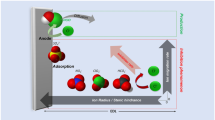Abstract
The present work contains results for artificial water electrolysis in discontinuous operation using laboratory reactors without separators. Rotating anodes with mixed oxide coatings containing IrO2/RuO2 were used. The experimental parameters were the chloride concentration, current density, rotation rate, cathode material, pH and water composition. Active and total chlorine concentrations and current efficiencies were obtained. It was shown that even for very low chloride concentrations, chlorine formation occurs, but side effects and side reactions significantly lower the efficiency in this case. Nitrite and ammonia formation was found to reduce the efficiency of chlorine formation. Partial polarization curves were obtained in kinetic experiments using solutions containing chloride and sulphate ions.
Similar content being viewed by others
Abbreviations
- Δ:
-
difference
- κ0 :
-
initial value of specific conductivity, S cm−1
- Λ:
-
equivalent ionic conductivity, m2 A V−1 mol−1
- Φ:
-
electrical potential, V
- \(\upvarphi\) :
-
current efficiency, %
- AC:
-
active chlorine
- c :
-
concentration, mg dm−3
- D :
-
coefficient of diffusion, m2 s−1
- diss.:
-
dissolved
- E :
-
electrode potential, V vs SHE
- F :
-
Faraday constant, A s mol−1
- i :
-
current density, mA cm−2
- I :
-
current, A
- j :
-
component j
- M :
-
Molaric mass, g mol−1
- N :
-
molaric flux, mol s−1 m−2
- n :
-
number of electrons
- rpm:
-
revolutions per minute
- SHE:
-
standard hydrogen electrode, V
- t :
-
time, s, min
- V :
-
electrolyte volume, dm3
- w :
-
velocity, m s−1
- x :
-
coordinate, m
- z :
-
charge number
References
H. Bergmann, T. Iourtchouk and K. Schöps, in ‘GDCh Monographie’, Vol. 23, 2001, pp. 155–162
Bergmann H., Iourtchouk T., Schoeps K., Ehrig F., (2001) gwf-Wasser, Abwasser 142: 856
Matsunaga T., Nakasono S., Masuda S., (1992) FEMS Microbiol. Lett. 93: 255
Slipcenko A.V., Slipcenko V.A., (1988) Elektron. Obrabotka materialov (Russ.) 1: 40
H. Bergmann, Neue Desinfektionstechnik/New disinfection technologies – Research Report BMBF/AIF Reg. No. 1703798 (2000), Anhalt University Koethen
Kraft A., Stadelmann M., Blaschke M., Kreysig D., Sandt B., Schröder P., (1999) J. Appl. Electrochem. 29: 861
Bergmann H., Iourtchouk T., Schoeps K., Bouzek K., (2002) Chem. Engin. Journ. 85: 111
Nieuwenhuijsen M.J. Toledano M.B., Eaton N.E., Fawell J., Elliott P., (2000) Occup. Environm. Med. 57: 73
Richardson S.D., Thruston A.D. JR, Caughran T.V., Chen P.H., Collette T.W., Schenck K.M., Lykins B.W. JR., Rav-Acha C., Glezer V., (2000) Water, Air and Soil Pollution 123: 95
Czarnetzki L.R., Janssen L.J.J., (1992) J. Appl. Electrochem. 22: 315
C. Oloman, ‘Electrochemical Processing for the Pulp and Paper Industry’, (The Electrochemical Consultancy, Underhill/England, 1996), 133 pp
Tasaka A., Tojo T., (1985) J. Electrochem. Soc. 132: 1855
S. Trasatti, in ‘Electrochemistry of Novel Materials’, (VCH Publishers, New York, 1994) 238 pp
Hsu Sh.-Y., (2005) J. Food. Ind. 66: 171
Gordon G., Emmert G., Gauw R., Bubnis B., (1998) Ozone Science and Engineering 20: 239
Bergmann H., (2005) gwf - Wasser, Abwasser 146: 126
Foller P.C., Tobias C.W., (1982) J. Electrochem. Soc. 129: 515
Dhar H.P., Bockris J.O’M., Lewis D.H., (1981) J. Electrochem. Soc. 128: 229
Lissens G., Pieters J., Verhaege M., Pinoy L., Verstraete W., (2003) Electrochimica Acta 48: 1655
Bouzek K., Paidar M., Sadilkova A., Bergmann H., (2001) J. Appl. Electrochem. 31: 1185
Gordon G., (2002) Journal American Water Works Association 94: 111
K. Höll (ed.), ‘Wasser’, (de Gruyter, Berlin, New York, 2002) 610 pp
D.R. Lide (ed.), ‘Handbook of Chemistry and Physics’, 83rd ed., (Boca Raton, FL, 2002), pp. 5–96
White G.C., (1999) Handbook of chlorination and alternatives disinfectants. John Wiley and Sons, New York
Author information
Authors and Affiliations
Corresponding author
Additional information
An erratum to this article can be found at http://dx.doi.org/10.1007/s10800-006-9143-x
Rights and permissions
About this article
Cite this article
Bergmann, M.E.H., Koparal, A.S. Studies on electrochemical disinfectant production using anodes containing RuO2 . J Appl Electrochem 35, 1321–1329 (2005). https://doi.org/10.1007/s10800-005-9064-0
Received:
Accepted:
Published:
Issue Date:
DOI: https://doi.org/10.1007/s10800-005-9064-0




